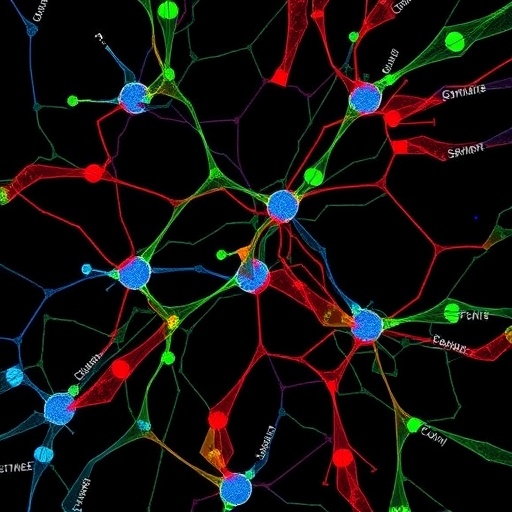In the realm of genetic research, the interplay between chromatin interactions and gene regulation is a field that continues to unveil layers of complexity and intrigue. A groundbreaking study conducted by Wit et al. has introduced a novel approach to mapping chromatin interactions, focusing specifically on SET1B, a crucial player in the epigenetic landscape of cellular function. This study, titled “Mapping SET1B chromatin interactions with DamID using DamMapper, a comprehensive Snakemake workflow,” has significant implications for our understanding of gene expression regulation and its aberrations in diseases.
The research harnesses the power of Dammethylation Interactions Detection (DamID), a technique that has emerged as a powerful method for studying protein-DNA interactions in vivo. Traditional methods often fall short in their ability to provide high-resolution maps of chromatin interactions due to various limitations concerning specificity and sensitivity. By employing DamID, the authors were able to chart the interactions of SET1B with unprecedented precision, thereby shedding light on the regulatory networks in which this enzyme is embedded.
The study introduces DamMapper, an innovative Snakemake workflow designed to streamline the analysis of DamID data. In an era where data generation is increasingly rapid, the ability to process and analyze vast amounts of genomic information efficiently is paramount. DamMapper addresses this need by offering a comprehensive framework that not only facilitates data processing but also enables reproducibility and accessibility in genomic research.
One of the core findings from Wit et al.’s research is the delineation of the SET1B chromatin landscape. It was observed that SET1B is not uniformly distributed across the genome; rather, its interactions are localized to specific regions associated with active gene transcription. This clustering of SET1B suggests a highly orchestrated mechanism by which chromatin states are established and maintained. The implications of these discoveries extend into various biological processes, including developmental biology and the pathology of diseases, particularly cancer.
Moreover, the study provides concrete evidence regarding the role of SET1B in shaping the three-dimensional architecture of the genome. The interactions between SET1B and chromatin regions appear to facilitate the formation of chromatin loops that promote enhancer-promoter interactions, a crucial component of gene activation. This functional insight into SET1B positions it as a potential target for therapeutic interventions, especially given its overexpression in specific malignancies.
As the findings of this research spread through the scientific community, they underscore the relevance of integrative genomics in unraveling the complexity of regulatory mechanisms. The authors discuss the advantages of using DamID over conventional methods, including less stringent requirements for the system and the ability to capture transient interactions that are often overlooked. This characteristic is particularly beneficial for studying proteins such as SET1B that may exhibit dynamic behavior in relation to chromatin.
Furthermore, the deployment of the DamMapper workflow represents a significant step forward in analytical genomics. By leveraging the power of Snakemake, the authors have created an environment conducive to reproducible research, which is an essential aspect of scientific integrity. Researchers can utilize this workflow to validate their findings or to extend their investigations into other chromatin-associated proteins.
In the context of future research, the implications of Wit et al.’s findings are vast. As the scientific community seeks to understand the underlying mechanisms of gene regulation further, the mapping of chromatin interactions will undoubtedly become increasingly critical. The insights gained from this study are likely to spur new investigations into the role of SET1B and related proteins in various biological processes and their potential as therapeutic targets in diseases encompassed within the epigenetic spectrum.
Interestingly, this research also opens doors to studying the influence of environmental factors on chromatin interactions. As scientists uncover how environmental stimuli can alter chromatin architecture, the role of epigenetic modifiers like SET1B may become a focal point in understanding these processes. This could prove beneficial in fields ranging from developmental biology to the treatment of complex diseases, highlighting the translational potential of such foundational research.
The impact of this study is likely to resonate beyond the immediate findings, pushing forward the methodology employed in genetic research. As researchers adopt and adapt the DamMapper workflow, the insights gained will fuel the next generation of exploration into gene regulation. Collaboration across various disciplines will be essential, as integrating techniques from computational biology, genomics, and molecular biology will maximize our understanding of the intricacies of life at a molecular level.
In a world where genetic information continues to expand, the pursuit of clarity in understanding gene regulation will remain a challenge. Nonetheless, with research as promising as that conducted by Wit et al., the tools and knowledge required to unravel these complexities are steadily being developed. Each new insight builds upon the last, propelling science towards breakthroughs that could redefine our understanding of genetics and its implications for human health.
In conclusion, the research conducted by Wit and colleagues signifies a turning point in our journey to decode the genetic blueprint of life. As the study illustrates, the integration of innovative methodologies such as DamID and tools like DamMapper, not only enhances our ability to investigate chromatin interactions but also propels us closer to deciphering the essential mechanisms governing gene expression. This work undoubtedly paves the way for future discoveries, as the detailed maps provided by this study will serve as invaluable assets in the ongoing exploration of the epigenetic landscape and its impact on health and disease.
Subject of Research: Mapping chromatin interactions of SET1B
Article Title: Mapping SET1B chromatin interactions with DamID using DamMapper, a comprehensive Snakemake workflow
Article References:
Wit, N., Bertlin, J., Hynes-Allen, A. et al. Mapping SET1B chromatin interactions with DamID using DamMapper, a comprehensive Snakemake workflow.
BMC Genomics 26, 914 (2025). https://doi.org/10.1186/s12864-025-12075-x
Image Credits: AI Generated
DOI: 10.1186/s12864-025-12075-x
Keywords: chromatin interactions, SET1B, DamID, DamMapper, Snakemake workflow, gene regulation, epigenetics, enhancer-promoter interactions




